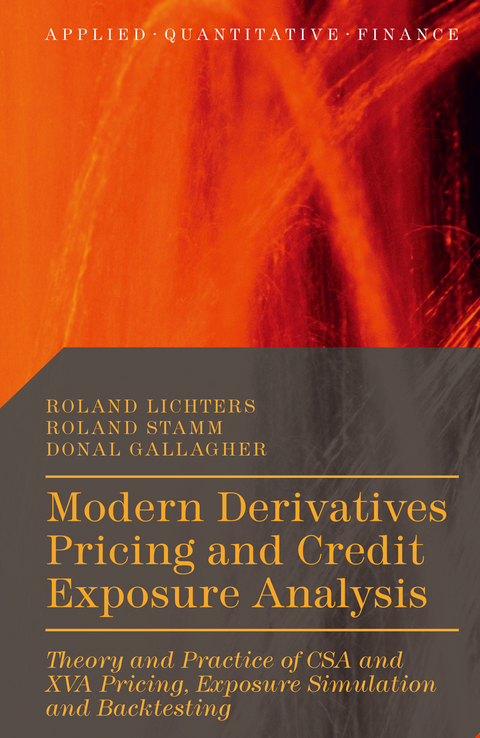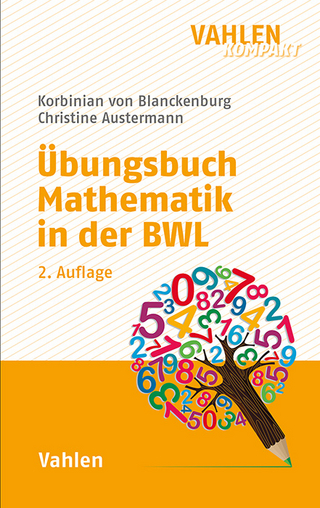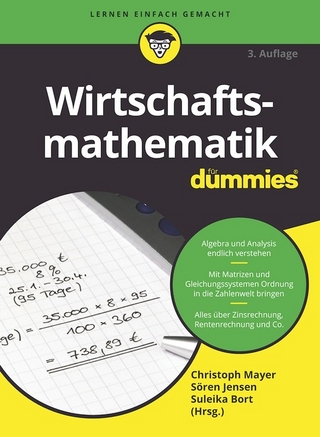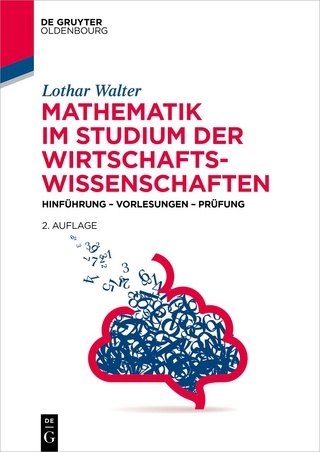
Modern Derivatives Pricing and Credit Exposure Analysis
Palgrave Macmillan (Verlag)
978-1-137-49483-2 (ISBN)
Roland Lichters has headed bank Risk and IT departments – building teams, processes, pricing/risk methodologies and systems. As founding Partner of Quaternion Risk Management, responsible for R&D, he focusses – besides his consulting and advisory work – on the company's QuantLib-based pricing and risk analytics products, implementing the methods covered in this book. Roland holds a PhD and Diploma in Physics and lectures part-time in Financial Engineering at Trinity College Dublin. Roland Stamm held senior positions in a number of banks' IT and Risk Management departments before joining Quaternion Risk Management as a Partner. In his banking work, he focused on market and credit risk methodology as well as the pricing and risk management of complex financial products. Roland holds a PhD in Mathematics and is co-author of the book Discounting, LIBOR, CVA and Funding (with Chris Kenyon) as well as a part-time lecturer. Donal Gallagher is a founding Partner and Managing Director of Quaternion Risk Management and advises CFOs and CROs on the transparent pricing, risk and capital management of complex financial instruments. His research interests include default models and portfolio credit products. Donal holds a PhD from the California Institute of Technology in Applied Mathematics and lectures part time in Financial Engineering at Trinity College Dublin.
Contents Preface Acknowledgments PART I: DISCOUNTING 1. Discounting Before the Crisis 1.1 The Risk-Free Rate 1.2 Pricing Linear Instruments 1.2.1 Forward Rate Agreements 1.2.2 Interest Rate Swaps 1.2.3 FX Forwards 1.2.4 Tenor Basis Swaps 1.2.5 Cross-Currency Basis Swaps 1.3 Curve Building 1.4 Pricing Non-Linear Instruments 1.4.1 Caps and Floors 1.4.2 Swaptions 2 What ChangedWith the Crisis 2.1 Basis Products and Spreads 2.1.1 Tenor Basis Swaps 2.1.2 Cross-Currency Basis Swaps 2.2 Collateralization 3 Clearing House Pricing 3.1 Introduction of Central Counterparties 3.2 Margin Requirements 3.3 Building the OIS Curve 3.4 USD Specialties 3.5 Building the Forward Projection Curves 3.6 More USD Specialties 3.7 Example: Implying the Par Asset Swap Spread 3.8 Interpolation 3.9 Pricing Non-Linear Instruments 3.9.1 European Swaptions 3.9.2 Bermudan Swaptions 3.10 Not All Currencies Are Equal 4 Global Discounting 4.1 Collateralization In a Foreign Currency 4.2 Non-Rebalancing Cross-Currency Swaps 4.3 Rebalancing Cross-Currency Swaps 4.4 Examples: Approximations of Basis Spreads 4.4.1 Tenor Basis Spreads 4.4.2 Flat Cross-Currency Swaps 4.4.3 OIS Cross-Currency Basis Spread 4.4.4 LIBOR Cross-Currency Basis Spread 5 CSA Discounting 5.1 ISDA Agreements and CSA Complexities 5.2 Currency Options 5.3 Negative Overnight Rates 5.4 Other Assets as Collateral 5.5 Thresholds and Asymmetries 5.6 Some Thoughts on Initial Margin 6 Fair Value Hedge Accounting 6.1 Introduction 6.2 Hedge Effectiveness 6.3 Single-Curve Valuation 6.4 Multi-Curve Valuation PART II: CREDIT AND DEBIT VALUE ADJUSTMENT 7 Introduction 8 Fundamentals 8.1 Unilateral CVA 8.2 Bilateral CVA 9 Single Trade CVA 9.1 Interest Rate Swap 9.1.1 Exercise within interest periods 9.1.2 Amortizing Swap 9.1.3 A Simple Swap CVA Model 9.2 Cash-Settled European Options 9.3 FX Forward 9.4 Cross-Currency Swap 9.5 Rebalancing Cross-Currency Swap PART III: RISK FACTOR EVOLUTION 10 A Monte Carlo Framework 11 Interest Rates 11.1 Linear Gauss Markov Model 11.1.1 Multiple Curves 11.1.2 Invariances 11.1.3 Relation to the Hull-White model in T-Forward Measure 11.2 Products 11.2.1 Zero Bond Option 11.2.2 European Swaption 11.2.3 Bermudan Swaption with Deterministic Basis 11.2.4 Stochastic Basis 11.3 CSA Discounting Revisited 11.4 Exposure Evolution Examples 12 Foreign Exchange 12.1 Cross-Currency LGM 12.2 Multi-Currency LGM 12.3 Calibration 12.3.1 Interest Rate Processes 12.3.2 FX Processes 12.3.3 Correlations 12.4 Cross-Currency Basis 12.5 Exposure Evolution Examples 13 Inflation 13.1 Products 13.2 Jarrow-Yildirim Model 13.2.1 Calibration 13.2.2 Foreign Currency Inflation 13.3 Dodgson-Kainth Model 13.3.1 Calibration 13.3.2 Foreign Currency Inflation 13.4 Seasonality 13.5 Exposure Evolution Examples 14 Equity and Commodity 14.1 Equity 14.2 Commodity 15 Credit 15.1 Market 15.2 Gaussian Model 15.2.1 Conclusion 15.3 Cox-Ingersoll-Ross Model 15.3.1 CIR without Jumps 15.3.2 Relaxed Feller Constraint 15.3.3 CDS Spread Distribution 15.3.4 CIR with Jumps: JCIR 15.3.5 JCIR Extension 15.3.6 Examples: CDS CVA and Wrong-Way Risk 15.3.7 Conclusion 15.4 Black-Karasinski Model 15.5 Peng-Kou Model 15.5.1 Review CDS and CDS Option 15.5.2 Compound Poisson Process 15.5.3 Compound Polya Process 15.5.4 Examples 15.5.5 Conclusion PART IV: XVA 251 16 Cross-Asset Scenario Generation 16.1 Expectations and Covariances 16.2 Path Generation 16.3 Pseudo Random vs Low Discrepancy Sequences 16.4 Long-Term Interest Rate Simulation 17 Netting and Collateral 17.1 Netting 17.1.1 Non-netted Counterparty Exposures 17.1.2 Netting Set Exposures 17.1.3 Generalized Counterparty Exposures 17.2 Collateralization 17.2.1 Collateralized Netting Set Exposure 17.2.2 CSA Margining 17.2.3 Margin Settlement 17.2.4 Interest Accrual 17.2.5 FX Risk 17.2.6 Collateral Choice 18 Early Exercise and American Monte Carlo 18.1 American Monte Carlo 18.2 Utilizing American Monte Carlo for CVA 19 CVA Risk and Algorithmic Differentiation 19.1 Algorithmic Differentiation 19.2 AD Basics 19.3 AD Examples 19.3.1 Vanilla Swap and Interest Rate Sensitivities 19.3.2 European Swaptions with Deltas and Vega Cube 19.4 Further Applications of AD 20 FVA 20.1 A Simple Definition of FVA 20.2 DVA = FBA? 20.3 The Role of the Spreads 20.4 The Expectation Approach 20.5 The Semi-Replication Approach 20.6 MVA 20.7 Outlook 21 KVA 325 21.1 KVA by Semi-Replication 21.2 Calculation of KVA 21.3 Risk-Warehousing and TVA PART V: CREDIT RISK 22 Introduction 22.1 Fundamentals 22.2 Portfolio Credit Models 22.2.1 Independent Defaults 22.2.2 Static Default Correlation Modelling 22.2.3 Dynamic Default Correlation Modelling 22.3 Industry Portfolio Credit Models 23 Pricing Portfolio Credit Products 23.1 Introduction 23.2 Synthetic Portfolio Credit Derivatives 23.2.1 Nth-to-Default Basket 23.2.2 Synthetic Collateralized Debt Obligation 23.2.3 Synthetic CDO2 23.3 Cashflow Structures 23.3.1 Introduction 23.3.2 Cashflow CDO Structures 23.3.3 Overall Pricing Framework 23.3.4 Pricing Formulas 23.4 Example Results 23.4.1 Test Deal 23.4.2 Test Results 23.4.3 Discussion of Results 24 Credit Risk for Derivatives 24.1 Introduction 24.2 Potential Future Exposure 24.3 Real-World Measure 24.3.1 Traditional Approach 24.3.2 Adjusted Risk-Neutral Approach 24.3.3 Joint Measure Model Approach 24.4 Standardized Approach, CEM and SA-CCR 24.4.1 Current Standardized Approach: CEM 24.4.2 New Standardized Approach: SA-CCR 24.5 Basel Internal Model Approach 24.6 Capital Requirements for Centrally Cleared Derivatives 24.7 CVA Capital Charge 24.7.1 The Standard Approach 24.7.2 The IMM Approach 24.7.3 Mitigation of the CVA Capital Charge 24.7.4 Basel Exposure Measures 24.7.5 Exemptions 25 Backtesting 25.1 Introduction 25.2 Backtest Model Framework 25.2.1 Example: Anderson-Darling Test 25.3 RFE Backtesting 25.3.1 Creating the Sample Distance and Sampling Distribution 25.3.2 Example I: Risk-Neutral LGM 25.3.3 Example II: Risk-Neutral LGM with Drift Adjustment 25.4 Portfolio Backtesting 25.5 Outlook PART VI: APPENDIX A The Change of Numeraire Toolkit B The Feynman-Kac Connection C The Black76 Formula C.1 The Standard Black76 Formula C.2 The Normal Black76 Formula D Hull-White Model D.1 Summary D.2 Bank Account and Forward Measure D.3 Cross-Currency Hull-White Model E Linear Gauss Markov Model E.1 One-Factor E.2 Two Factors E.3 Cross Currency LGM F Dodgson Kainth Model F.1 Domestic Currency Inflation F.2 Foreign Currency Inflation G CIR Model with Jumps H Filtration Switching and the PK Model Bibliography Index
| Reihe/Serie | Applied Quantitative Finance |
|---|---|
| Zusatzinfo | XXXII, 466 p. |
| Verlagsort | Basingstoke |
| Sprache | englisch |
| Maße | 155 x 235 mm |
| Themenwelt | Mathematik / Informatik ► Mathematik ► Finanz- / Wirtschaftsmathematik |
| Naturwissenschaften | |
| Wirtschaft ► Allgemeines / Lexika | |
| Wirtschaft ► Betriebswirtschaft / Management ► Finanzierung | |
| Wirtschaft ► Volkswirtschaftslehre ► Ökonometrie | |
| ISBN-10 | 1-137-49483-2 / 1137494832 |
| ISBN-13 | 978-1-137-49483-2 / 9781137494832 |
| Zustand | Neuware |
| Informationen gemäß Produktsicherheitsverordnung (GPSR) | |
| Haben Sie eine Frage zum Produkt? |
aus dem Bereich


